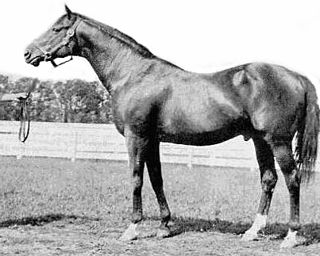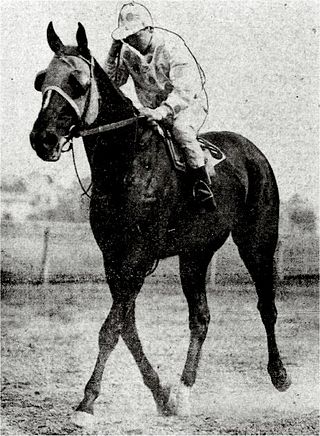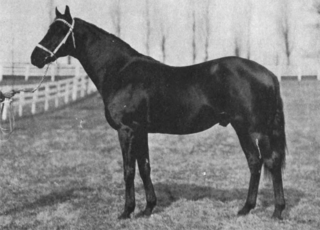Related Research Articles

Hindoo (1878–1901) was an outstanding American Thoroughbred race horse who won 30 of his 35 starts, including the Kentucky Derby, the Travers Stakes, and the Clark Handicap. He later sired Preakness Stakes winner Buddhist and Belmont Stakes winner and Leading sire in North America Hanover.
Idle Hour Stock Farm was a 400-acre (1.6 km2) thoroughbred horse breeding and training farm near Lexington, Kentucky, United States established in 1906 by Colonel Edward R. Bradley.

Colin was an undefeated champion American Thoroughbred racehorse who won all his 15 races including the 1908 Belmont Stakes and was the 1907 and 1908 Horse of the Year as well as the 1907 Champion Two-Year-Old Male and 1908 Champion 3-Year-Old Male and was inducted into the National Museum of Racing and Hall of Fame.
The Eclipse Award is an American Thoroughbred horse racing award named after the 18th-century British racehorse and sire, Eclipse.
The Acorn Stakes is an American Grade I race at Belmont Park in Elmont, New York for three-year-old Thoroughbred fillies. It is raced on dirt over a distance of one mile and a sixteenth with a current purse of $500,000. It is the first leg of the US Triple Tiara and is followed by the Coaching Club American Oaks then the Alabama Stakes. The filly must win all three races to win the Triple Tiara, as well as the third leg of the "National" Triple Tiara.
John M. Veitch was an American Hall of Fame Thoroughbred horse trainer. The son of U.S. Racing Hall of Fame trainer Sylvester Veitch, he belonged to a family that has been in the horse-training business for three generations.
Blue Larkspur (1926–1947) was a bay Kentucky-bred thoroughbred race horse. He was inducted into the National Museum of Racing and Hall of Fame in 1957, and ranks Number 100 in The Blood-Horse's top 100 U.S. thoroughbred champions of the 20th Century. Of the 127 stakes winners bred by Colonel Edward Riley Bradley at his Idle Hour Stock Farm in Lexington, Kentucky – which includes Bimelech out of La Troienne – Blue Larkspur was considered the Colonel's finest horse.
Wheatley Stable was the nom de course for the thoroughbred horse racing partnership formed by Gladys Mills Phipps and her brother, Ogden Livingston Mills. The horses were raised at Claiborne Farm near Paris, Kentucky.
Edward Riley Bradley was an American steel mill laborer, gold miner, businessman and philanthropist. As well as a race track proprietor, he was the preeminent owner and breeder of Thoroughbred racehorses in the Southern United States during the first three decades of the 20th century. Testifying before a United States Senate committee in April 1934, Bradley identified himself as a "speculator, raiser of race horses and gambler". He appeared on the cover of Time magazine on May 7, 1934. In the year 2000, the Florida Department of State honored him as one of their Great Floridians.

Peter Pan (1904–1933) was an American Thoroughbred racehorse and sire, bred and raced by prominent horseman, James R. Keene. As winner of the Belmont Stakes, the Brooklyn Derby and the Brighton Handicap, he was later inducted into the National Museum of Racing and Hall of Fame. His progeny included many famous American racehorses, including several winners of the Kentucky Derby and the Preakness Stakes.

Black Toney (1911–1938) was an American Thoroughbred racehorse and sire, owned and raced by Edward R. Bradley
Harvey Guy Bedwell was an American Hall of Fame trainer and owner of Thoroughbredracehorses who was the first trainer to win the U.S. Triple Crown.
MacKenzie "Mack" Todd Miller was an American Thoroughbred racehorse trainer and owner/breeder. During his forty-six-year career, he conditioned seventy-two stakes winners, including four Eclipse Award champions.
Stephen A. "Steve" DiMauro was a jockey, Champion trainer and successful breeder and owner in American Thoroughbred horse racing.
James P. Conway was an American Hall of Fame trainer in Thoroughbred horse racing who trained forty-three stakes winners including five Champions and a winner of two American Classic Races.
Caro (1967–1989) was an Irish-bred, French-trained Thoroughbred racehorse.
Winbert F. "Bert" Mulholland was an American Hall of Fame Thoroughbred horse racing trainer.

Swynford was a British Thoroughbred racehorse. Bred at the 16th Lord Derby's stud in Lincolnshire, England he was sired by John O'Gaunt, a son of Isinglass, winner of the British Triple Crown in 1893. His dam was Lord Derby's foundation mare and 1896 Epsom Oaks winner Canterbury Pilgrim who also produced Chaucer, the 1927 and 1933 Leading broodmare sire in Great Britain & Ireland.
Joseph Horace "Bud" Stotler was an American Thoroughbred horse racing Champion trainer who conditioned horses that won four Championships. He was of German descent.
The Eastern Shore Stakes was an American Thoroughbred horse race run between 1913 and 1949 at Havre de Grace Racetrack, in Havre de Grace, Maryland. A race for two-year-old horses of either sex, it was inaugurated and run for most of its existence as the Eastern Shore Handicap.
References
- ↑ "Herbert J. Thompson". Racingmuseum.org. 2016-09-06. Retrieved 2016-10-31.
- ↑ "Successor to Late Cliff Hammon". Daily Racing Form at University of Kentucky Archives. 1919-03-13. Retrieved 2020-02-11.